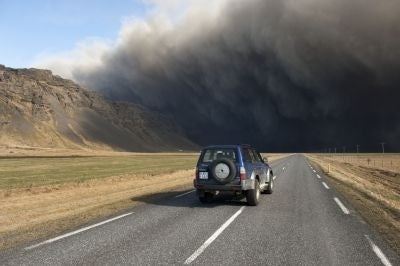When Iceland's Eyjafjoell volcano began acting up a year ago, no one could foresee the small eruption would soon lead to the planet's largest air space shutdown since World War II.
Today, ash still covers a wide area around the blast site, which still bears the label of volcanic hazard area and European officials continue to scratch their heads over how they will avoid similar chaos if such an eruption happens again.
After lying dormant since 1823, the volcano under the Eyjafjallajokull glacier awoke with a bang in March last year as its Finnvurdahals crater offered a magnificent spectacle of burning red lava falls, attracting throngs of tourists and volcano watchers and even chefs eager to cook over the magma.
So when just days after that eruption subsided another one of the volcano's craters rumbled to life on April 14, 2010, many expected another windfall to Iceland's tourism industry.
Instead the world witnessed a daunting, air space-paralysing plume of ash that rose to heights of up to 9,000 metres (nearly 30,000 feet).
Wind pushed the ash southeast and by evening it had reached the skies over Norway, which promptly closed its airspace for fear the fine ash would clog up aircraft engines and reduce visibility.
The next day alone, more than 10 European countries followed suit in grounding all flights, and Eyjafjoell ended up wreaking havoc in European skies for almost a month, cancelling more than 100,000 flights and affecting more than 10 million travellers.
"That was a bit unexpected," Pall Einarsson, a geophysics professor at the University of Iceland and volcano specialist, said of the eruption-prompted chaos, noting the eruption itself was widely anticipated.
The surprising thing, he said, was "how much disturbance a small eruption like this could cause. That was because the ash was extraordinarily fine and the weather conditions were very unfavorable."
An especially viscous, very gassy and extremely explosive magma also took "the lava that would otherwise flow as just peaceful lava flow and shattered it into fine ash," Einarsson told AFP.
The volcano's violent ash column quickly died down, rising to less than half its original height some five days after the blast.
But the ash remained in the sky above Europe for a month and eventually reached as far as the east coast of Canada.
The international airline industry's umbrella body IATA put the revenue loss to carriers from the eruption at 1.8 billion US dollars (1.2 billion euros), according to a "conservative estimate" it released last June.
In Brussels, the question of Eyjafjoell has yet to be filed away, with the European Commission admitting this week work was still in progress to find a way to avoid similar chaos in the future.
"The intensive efforts over the last 12 months have paid off in terms of improving crisis planning and systems. But the work goes on," EU transport commissioner Siim Kallas said.
"Volcanoes and other aviation crises are by their nature unpredictable and each one will be different. We can never get to zero risk but we can make maximum efforts to prepare strong systems to cope with disasters," he said, citing "major improvements in international volcanic ash guidelines."
On Wednesday and Thursday, the International Civil Aviation Organisation was running a gigantic exercise simulating an eruption at Iceland's Grimsvoetn volcano involving more than 70 airlines along with Eurocontrol.
Back in Iceland, Eyjafjoell is keeping quiet for the one-year anniversary of its rise to global fame, with no activity seen at the closely-monitored volcano.
It has been cooling down since it stopped erupting at the end of May, Einarsson said.
Its outburst initially crippled Iceland's important tourism sector: first by preventing tourists reaching the island nation, and then by blocking access to the rural area around the volcano.
But a year on, "the tourism industry has recovered more quickly than people feared" with more international flights than ever before set to fly to Iceland for the summer season, said Halldor Arinbjarnarson of the Icelandic Tourist Board.
Tourists are also curious, he told AFP, to travel to the glacier where the havoc started, and "there are tour operators trying to use the volcano as an attraction."
rdm/nl/bm
Subscribe to Independent Premium to bookmark this article
Want to bookmark your favourite articles and stories to read or reference later? Start your Independent Premium subscription today.


Join our commenting forum
Join thought-provoking conversations, follow other Independent readers and see their replies
Comments